Hike & Recreation Guide
This story is part of an ongoing guide series to help readers find more ways to enjoy our community and the Ozarks outdoors.
Wilson’s Creek National Battlefield is one of the Springfield metro area’s most enriching outdoor assets. Not only does it have historical significance as the site of the Civil War’s first major battle west of the Mississippi River, but the roughly 2,000-acre natural greenspace is also a great place to walk, run, cycle, ride horses and hike a network of trails. Visitors to the park enjoy recreation backdropped by a meandering creek, woods, meadows and 1800s-era buildings and artifacts.
And now, you can do it all for free!
As of Jan. 1, entering the battlefield just southwest of Springfield no longer requires a day fee, annual pass or feeding the entrance gate with metal tokens to raise the arm. Now the gate’s arm is on a timer, rising for vehicles at 8 a.m. daily. If you’re on foot or on a bicycle, you can enter the park at dawn before the arm goes up. The park stays open until dusk. The Visitor Center, however, still has specific days and hours when the doors are open and staff are on hand.
Wilson’s Creek Chief of Interpretation Alicea Powell said when the park reviewed visitation numbers, the staff determined the public benefit of making it free to enter outweighed the associated costs with collecting fees. Plus, the change brings the battlefield in line with Missouri’s other six National Park Service sites that charge no admission.
Learn more about the economic impact of visitors to Wilson’s Creek (click to expand)
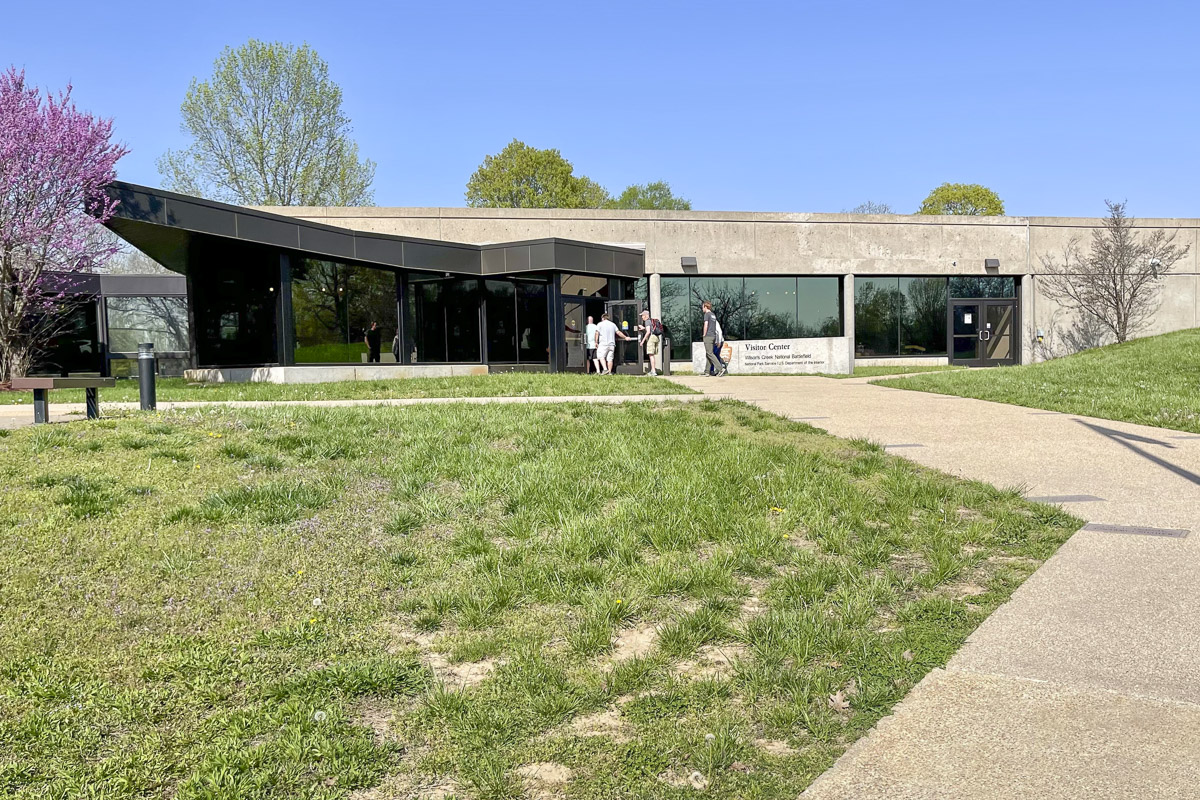
Collected data shows Wilson’s Creek National Battlefield saw a jump in annual visits from 232,838 in 2019 to 287,260 in 2020. Visits dropped back a bit in 2021 but increased to 282,914 in 2022. And they appear to be rising again in 2023, according to year-over-year statistics that show total visits through March are up by 9% compared to last year. Powell says it’s hard to determine whether that’s because fees were eliminated or whether it’s part of a longer upward trend. Visits have increased each year since 2016.
A Visitor Spending Report summarized the impact of 271,245 visitors to Wilson’s Creek in 2021. According to the data, visitors spent $17.7 million in communities near the park, supporting 263 jobs. The cumulative benefit to the local and gateway economies was nearly $24 million. Nearly 96% of spending was by visitors from outside the Springfield metro area.
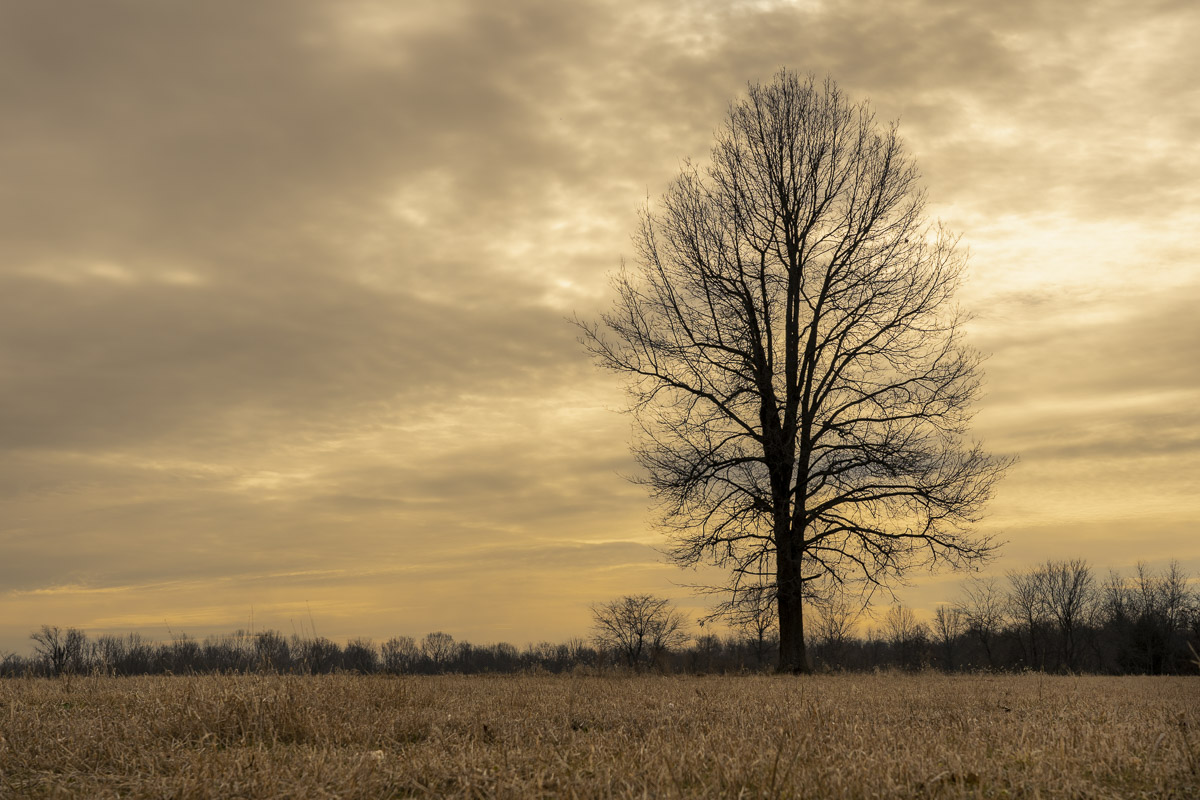
When it comes to enjoying outdoor activities within 10 minutes of urban development, Wilson’s Creek National Battlefield is akin to the Springfield Conservation Nature Center, Fellows Lake, Ritter Springs and Lost Hill parks, Fulbright Spring Trail and other nature spaces on the outskirts of Springfield.
There is one important difference, Powell says: While the park at Wilson's Creek is indeed recreational, it was preserved as the site of an important historic battle with more than 2,500 casualties.
“We are here for commemorative purposes,” Powell said. “So also recognize the need to respect this place as a location where many people lost their lives.”
If you have never visited Wilson’s Creek National Battlefield — or if it’s been a while since you have — this guide will help you start exploring. We focus on the park’s recreational benefits with a generous side of history.
Need-to-know details about Wilson’s Creek National Battlefield (click to expand)
Location: 6424 W. Farm Road 182, Republic (10 to 30 minutes from most sections of Springfield; click here for some suggested directions)
Park phone: 417-732-2662
Online: nps.gov/wicr
Facebook: Wilsons Creek National Battlefield
Park and tour road hours: Roughly dawn (for walkers/cyclists) to dusk (tour road closes by 30 minutes after sunset), changing with the seasons and holidays; the automated gate for vehicle entry raises at 8 a.m.
Visitor Center and Museum hours: 8 a.m.-5 p.m. daily
Library hours: 9 a.m.-noon and 1-4 p.m. Tuesday-Saturday; or by appointment
Ray House: Open for staffed walkthroughs 10 a.m.-3 p.m. in June, July and August
Dogs: Allowed on leashes (please clean up after)
Horses: Allowed on designated trails; horse trailer parking is available
Bicycles: Allowed on the Tour Road
Wilson’s Creek National Battlefield Foundation: wilsonscreek.com; (417) 861-9905
Online resources: Park safety rules; interactive points of interest map; trail map
Events at Wilson’s Creek National Battlefield
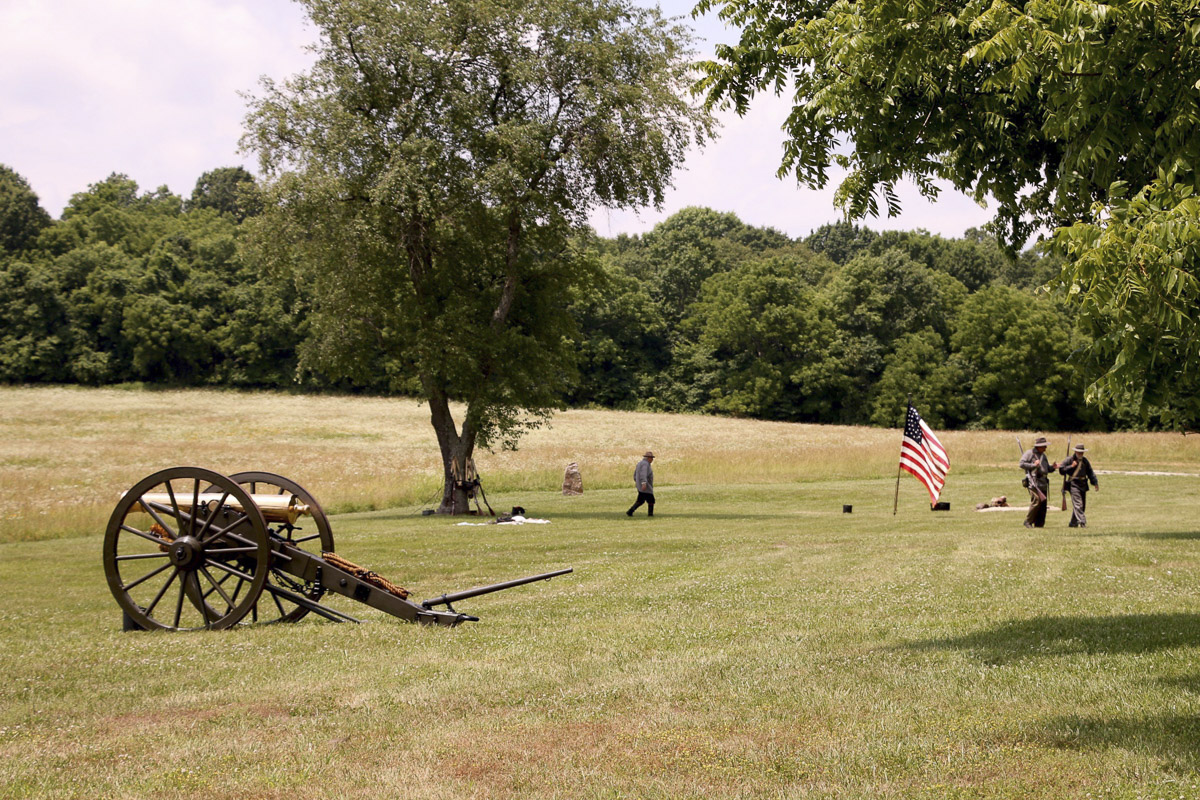
The battlefield hosts public events during most warm season months, now all with free admission. Many of those are “living history” programs about the Civil War and life as a soldier.
To learn about upcoming events, click on the calendar page, then click through to your month of interest. Updated details about events can be found on the park’s Facebook page.
A few upcoming events in 2023 include the following (click to expand)
B.A.R.K Ranger Program
April 29; activity times and details are available on Facebook
The new B.A.R.K. Ranger program will be launched with a veterinarian visit and distribution of “bark booklets” and dog tags.
Arts in the Park
7-8 p.m., May 6, 13, 20, 27
Various music groups will play period music each Saturday evening on the front lawn of the Visitor Center. Bring a lawn chair or blanket to sit on. Music groups will be announced on the battlefield’s Facebook page.
Ray House Jamboree
10 a.m.-3 pm., June 3 at the Ray House (Tour Road Stop No. 2)
Features period music and other activities
Sigel’s Germans Infantry Programs / Wilson’s Creek NB Artillery Demonstrations
10 a.m.-4 p.m., June 10 at Tour Road Stop 5
Infantry and artillery programs lasting 30-45 minutes will alternate on the hour every hour, beginning with Infantry at 10 a.m. Information
Artillery Demonstrations
11 a.m.-3 p.m. June 24 at Tour Road Stop 5
Artillery demonstrations by U.S. National Park Service staff and volunteers will begin on the hour every hour, lasting approximately 30-45 minutes, with a firing at the beginning and end of the program.
Visitor Center: Battle and park information
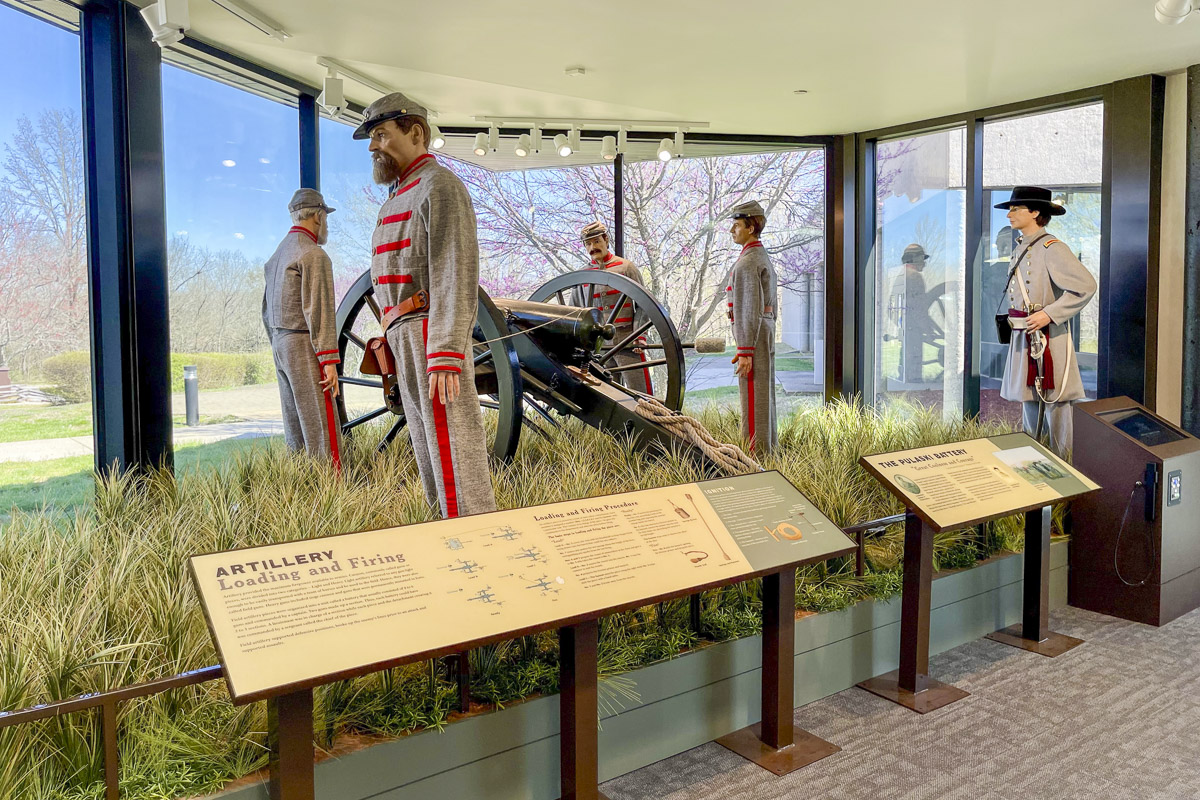
If you aren’t familiar with the park, start at the recently renovated Visitor Center where you can pick up a trail map and a battlefield brochure, or learn about the park from rangers and staff.
“We encourage people to stop in at the Visitor Center to get any current information and to make those staff connections,” Powell said. “They can get our map, and if they have questions about the topography of any of the trails, staff can help them identify what route might be best for them, based on what they're looking for.”
The Visitor Center Museum, 1,800 square feet larger than before, includes the original “Lyon bed.” This is the bed where Gen. Nathaniel Lyon’s body was laid in John Ray’s farmhouse after Lyon was killed in the Battle of Wilson’s Creek. The 1852 Ray House served as a makeshift field hospital after the battle. Lyon was the first Union general to be killed in action as a result of the Civil War. The original bed was moved from the Ray House to the museum for a safer environment and protection against humidity, Powell says. A replica was built for the historic house located at Stop 2 on the Tour Road.
In addition, the museum features updated interactive exhibits, virtual displays and historic artifacts including a rare Model 1860 Henry repeating rifle. One of the most popular exhibits, Powell says, is the three-dimensional interactive battlefield map where visitors can learn firsthand, with an 8-minute audio program, how the battle moved through the rural landscape on Aug. 10, 1861. Although Union soldiers were outnumbered two-to-one and succumbed to a Confederate victory, it was considered a major battle and brought attention to the war in Missouri. The museum also features a 29-minute film and a Junior Ranger Program for young visitors. Powell suggests adults pick up Junior Ranger materials, too, for a more simplified explanation of the battle.
Learn more about the battle from the National Park Service and the Kansas City Public Library. This Ozarks Alive article shares stories about the families affected by the battle, especially the Ray family.
Tour Road: Recreation and history
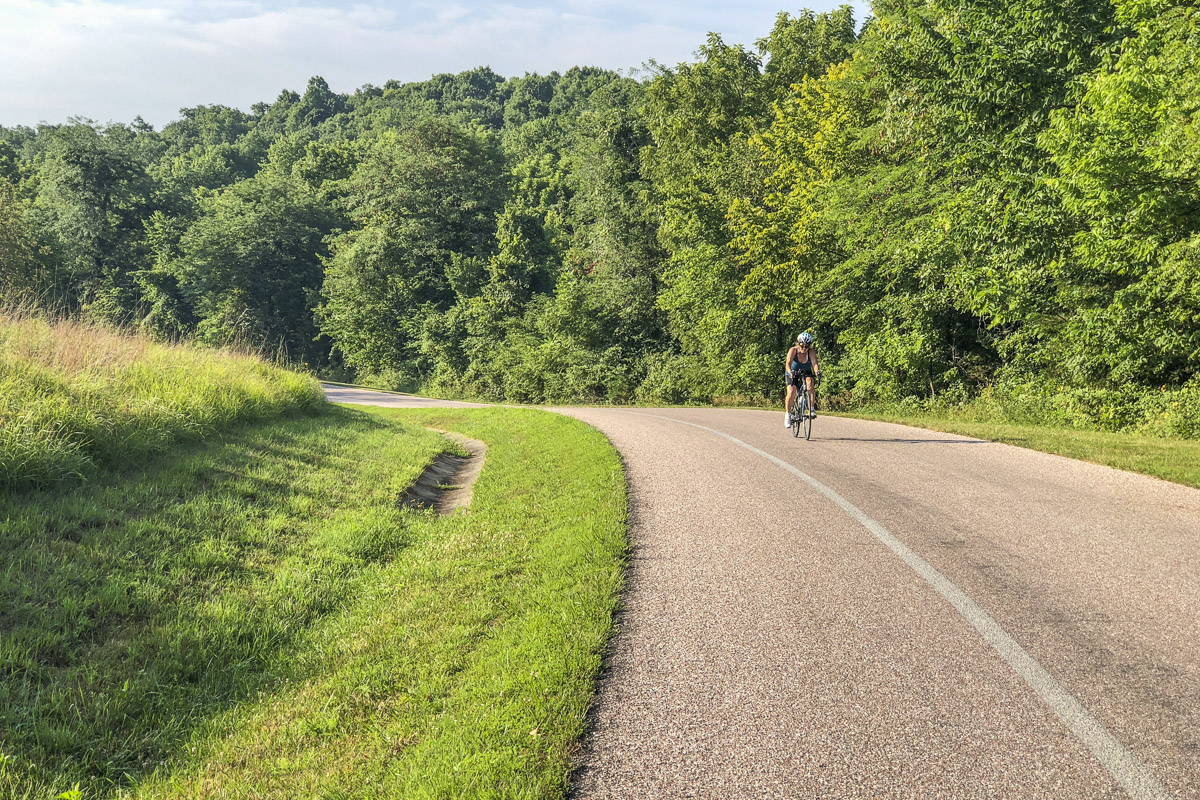
The 5-mile Tour Road — open from 8 a.m. to dusk each day — serves as both a historic journey and a recreational pathway. In addition to attracting visitors by car, the hilly one-way road is a popular spot for walkers, runners and cyclists. A wide pedestrian/bike path allows all users to share the road.
Not only is the Tour Road a scenic, safe path to navigate, but pedestrians can also stop along the way for views and historic spots people in cars can only pass. That’s because parking is limited to eight designated stops on the self-guided historic tour, each telling a piece of the battle’s story.

Tour Road Stop 2 takes you to the Ray House, which played a significant part in the battle story
Click for more details on the Ray House
The house is open with limited hours in June, July, and August, but visitors can always sit on the porch, peek in the windows and walk the grounds while imagining what the battle must have been like for the 19th century farming family headed by John Ray, who lived in the home with his wife Roxanna and their nine children.

“The Ray House is kind of an exhibit of the civilian life during that time,” Powell said. “The house itself was also significant due to being used as a field hospital during the battle.”
Historians can’t know exactly how the rooms were arranged when the Ray family lived there, so it’s not 100 percent accurate to what it looked like on Aug. 9, 1861, Powell says, “but it is set up to give people an idea and a perspective of the civilian involvement.”
If you’re on foot or bike, plan also to pause at Tour Road Stop 7, known as Bloody Hill. There’s a good chance you’ll need to catch your breath here after navigating the long, steep hill to this point. Many Tour Road stops are also trailheads to explore the interior of the park (read our trail guide below).

Whether you drive, ride or go on foot, watch for wildlife in the early morning or nearing dusk. Deer and wild turkeys are among the park’s residents. With every season, you’ll enjoy the changing landscape: Fall color, winter textures, spring flowers and summer foliage.
Tour Road Highlights
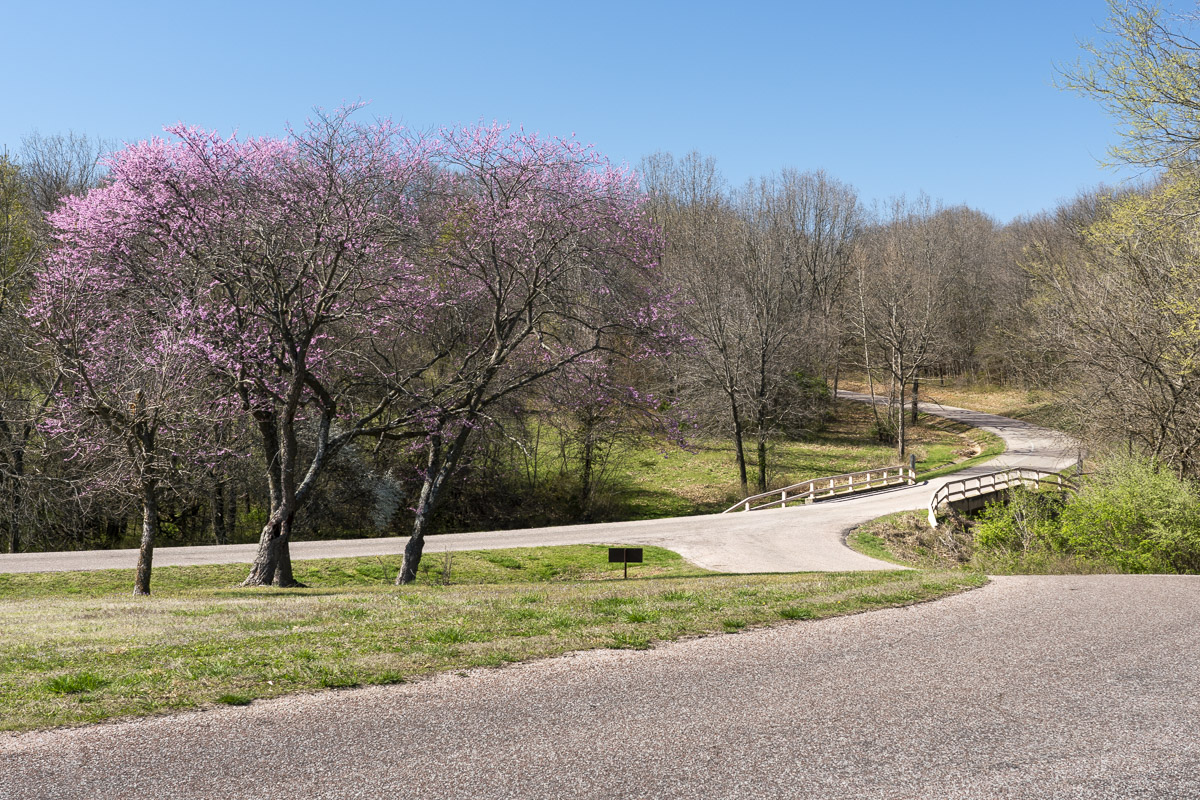
To preview the tour stops or to take a virtual tour of the battlefield, visit the National Park Service website.
We share a few highlights below (click to expand).
Tour Stop 1, Gibson’s Mill, offers a nice first view of the park. From here, you can walk over to the bridge to view Wilson’s Creek, or head to the woods on Gibson’s Mill Trail (more about trails below).
Tour Stop 2, the Ray House, illustrates how the Ray family played a significant role in the battle story. There are steps, a ramp and a wide path to reach the house on a hill where, during the battle, John Ray remained on the porch as his family and other farm residents stayed in the cellar. The Ray family’s springhouse, another structure that survived the battle, can be viewed from the west side of the road, across from the parking area. You can walk down to the springhouse along the split-rail fence.
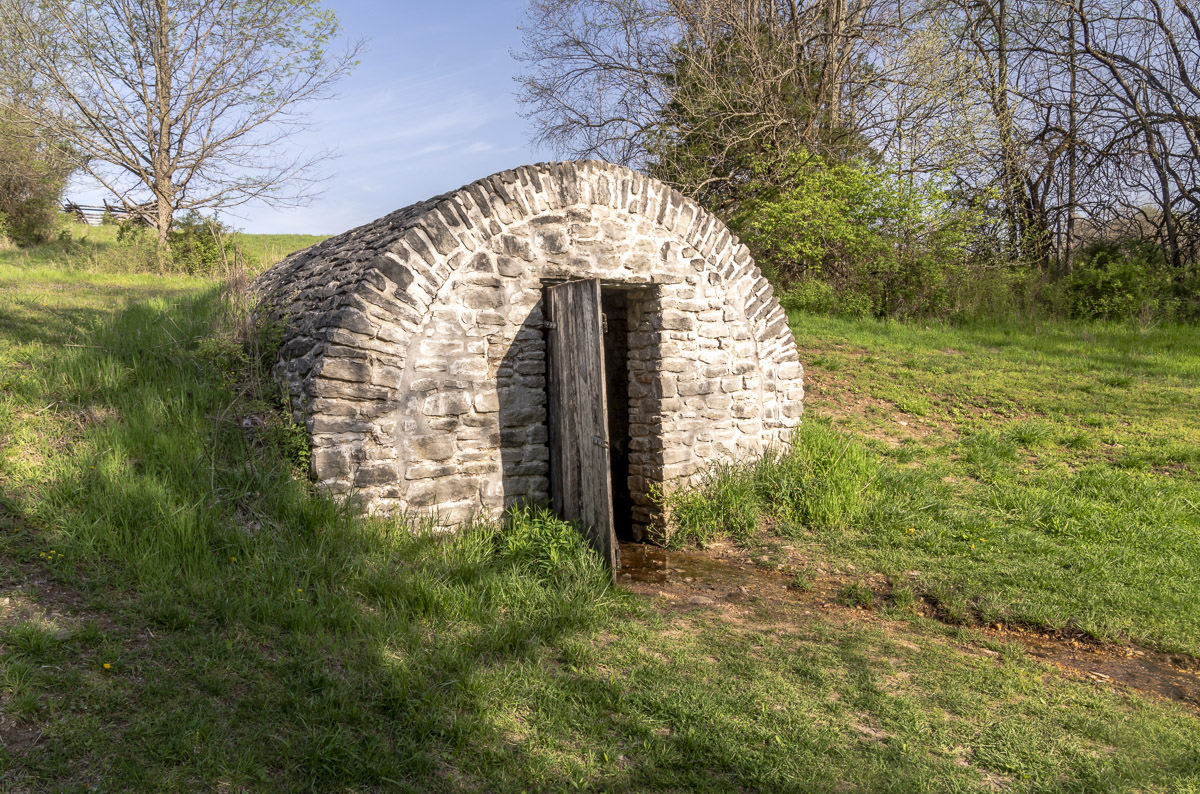
From Tour Stop 3, take the trail west to see the creek, visit what’s known as the Edwards Cabin (although the 1850s cabin is not the original cabin), and connect to other trails (see our trail guide). You can also cross the road to climb a trail to an overlook.
With a smaller parking spot, Tour Stop 4 provides a broad view of the Sharp farm and another battle spot. From here, you could also walk back to a bridge to look at the creek.
There’s a large parking lot at Tour Stop 5 on the historic Wire Road (now part of the trail system), known as Sigel’s Final Position. This is the stop where artillery demonstrations and many other events are held.
Tour Stop 6, Guibor’s Battery, has a small parking area to see four canons that impacted the battle on Bloody Hill, the next stop.
The most intense fighting happened on Bloody Hill, Tour Stop 7 with a large parking area. Here, visitors can learn more about the battle and take a .75-mile trail to the spot where Union commander Brigadier General Nathaniel Lyon was mortally wounded.
Finally, Tour Stop 8 with a small pull-off, is the site where the Battle of Wilson’s Creek began and ended, according to the NPS.
Trails: Hike your way around the park
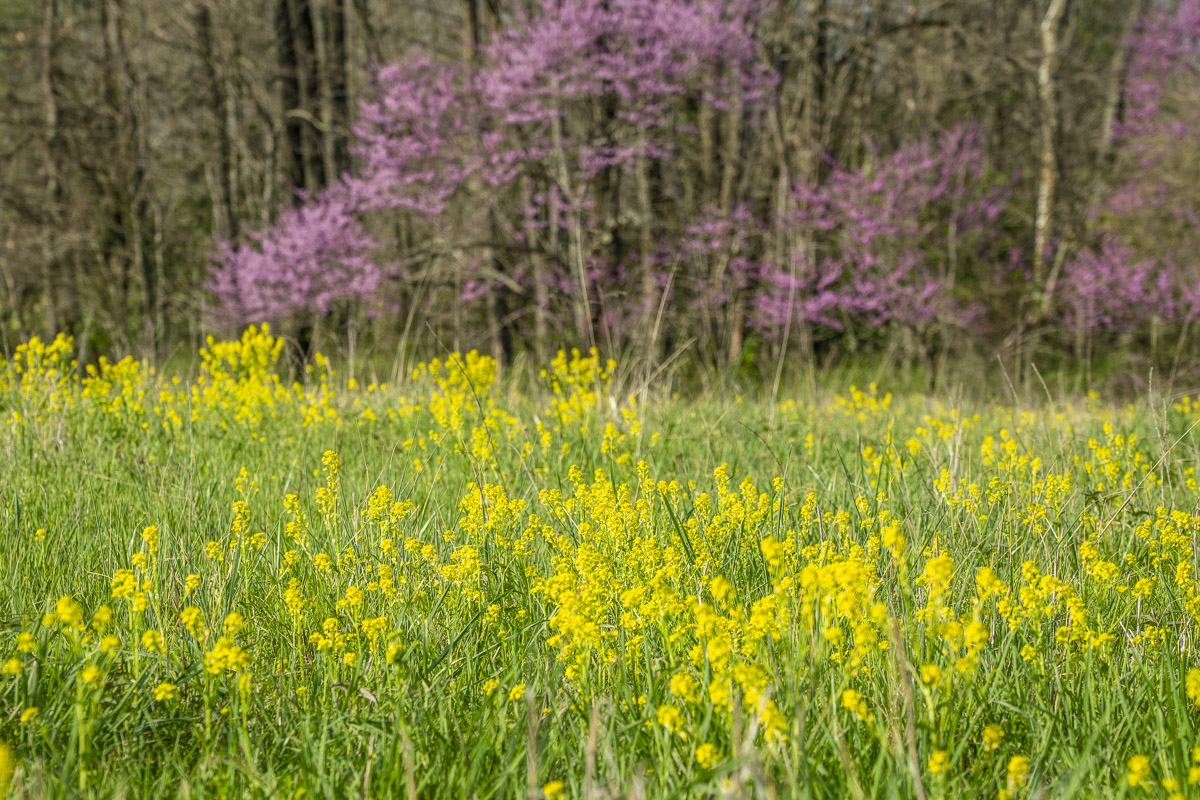
I’m partial to the seven-mile network of interconnecting trails that crisscross Wilson’s Creek National Battlefield. That includes part of the historic Wire Road, preserved as a park trail. Not only can you get a good hiking workout up and down slopes (if you choose hilly pathways), the trails lead to historic spots you can’t see from the road.
“The trails can take you out to some of the important battle sites that you can't get out to otherwise,” Powell said. “I think it is definitely an interesting way to continue to explore the history — walking in the footsteps of the soldiers to these different locations. Because they obviously weren't driving a (tour) road.”
It’s also a place full of natural beauty and wildlife. In fact, it’s not unusual to see photographers and birdwatchers navigating the park. And if you visit near dawn or dusk, you may encounter deer or turkey.
“There are some really great zones where we see a lot of bird activity,” Powell said. “So it's certainly a spot where you can use these trails to be able to connect to the history, the cultural landscape and the natural landscape of the area.”
Best of all, the trails leading through woods and glades along Wilson’s Creek provide a healthy dose of “nature RX” within minutes of Springfield. All the trails can be hiked, and five accessible walking trails (.25 to .75 miles in length) can be reached via the tour road. Horses are allowed on four of the trails: Wire Road, Ray Cornfield, Southwest and Manley Uplands. There is designated parking for horse trailers.
Stop by the Visitor Center to pick up a park brochure and a color-coded trail map that lists distances, difficulty levels, and whether horses are allowed. Or check out two trail maps online (from the National Park Service or download this map) for reference.
Keep reading for some of our favorite suggested hiking routes.
Tour Stop 3 / Trail Central

Tour Road Stop No. 3 is my favorite go-to for hiking, whether I only have time for a short trek or plan for a longer stretch of the legs. That’s because there are so many route variations from this stop. Here are my favorites (click to expand each one for additional details).
East Overlook Trail: This .25-mile trail starts at the steps across the street, east of the parking lot, and goes up to an overlook.
Click for more details
After climbing the stairs, cross a bridge and keep going east up the hill, a 60-foot elevation change. The top of the trail includes interpretative signage and a view of the battlefield (if it’s not too leafed out yet). This could also be a nice wooded area with little foot traffic for a blanket picnic.

Pulaski Battery Trail: This is the primary trailhead spur at Stop 3 that leads west from the parking lot to other trail connections.
Click for more details
This trail goes downhill on a gravel path that’s relatively easy, but can be uneven in spots. When you get to the bottom after crossing a bridge, you have several options. One is to complete this short trail up to its end at the Pulaski Battery with interpretive signage, canons and a nice view. Another choice is to take a sharp right and follow the Wire Road trail northeast up to the Tour Road (it comes out just south of Stop 2).
My two favorite route options from here are described below.
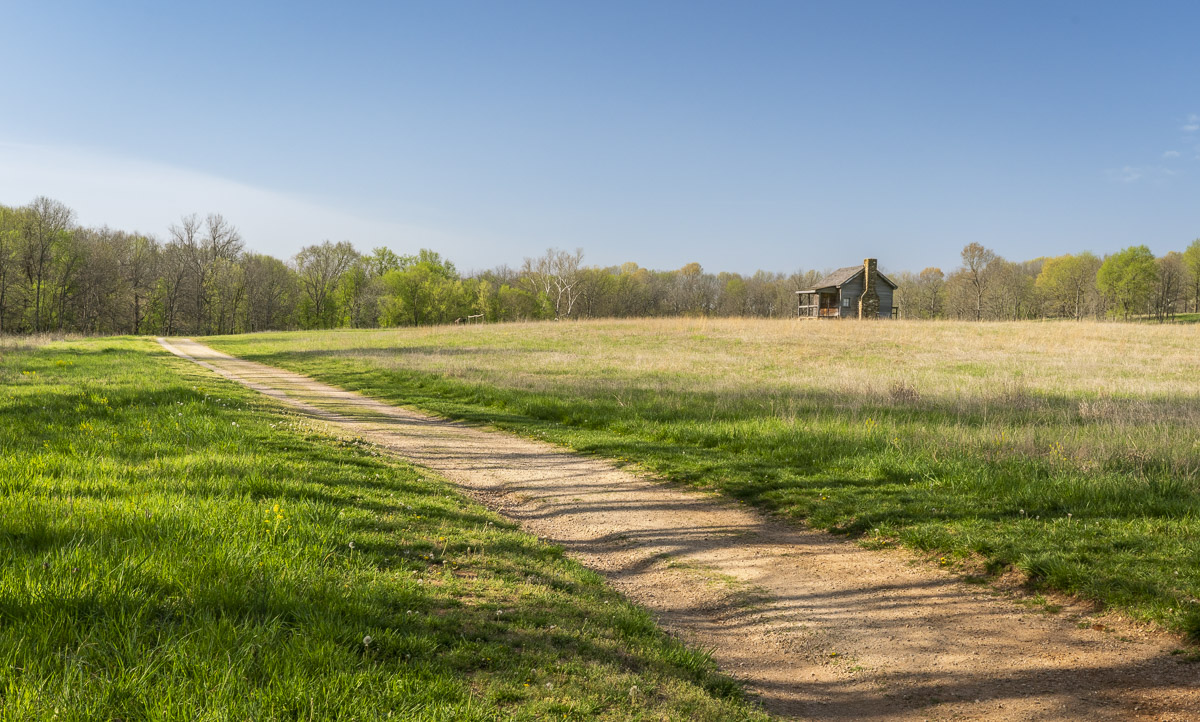
Wire Road Trail / Edwards Cabin: After crossing the bridge at the bottom of the Pulaski Battery Trail spur (see above), turn left on the Wire Road Trail and follow it southwest toward the Edwards Cabin.
Click for more details
For a pleasant, pretty shorter trek, stay on the Wire Road as it crosses a bridge over Wilson’s Creek and continues toward the cabin. The walk goes by a wooded creek bank on your left and a large field to your right. (Note: As you walk Wire Road you’ll pass a sign for the Bloody Hill Spur, which you can take later for additional exploration.)
At the cabin, you can read an interpretive sign and walk around the 1850s structure. It’s not the original family cabin of farmer William Edwards but was placed in the same spot in the 1970s. The site is significant to the battle because Confederate General Sterling Price established his headquarters next to the cabin.
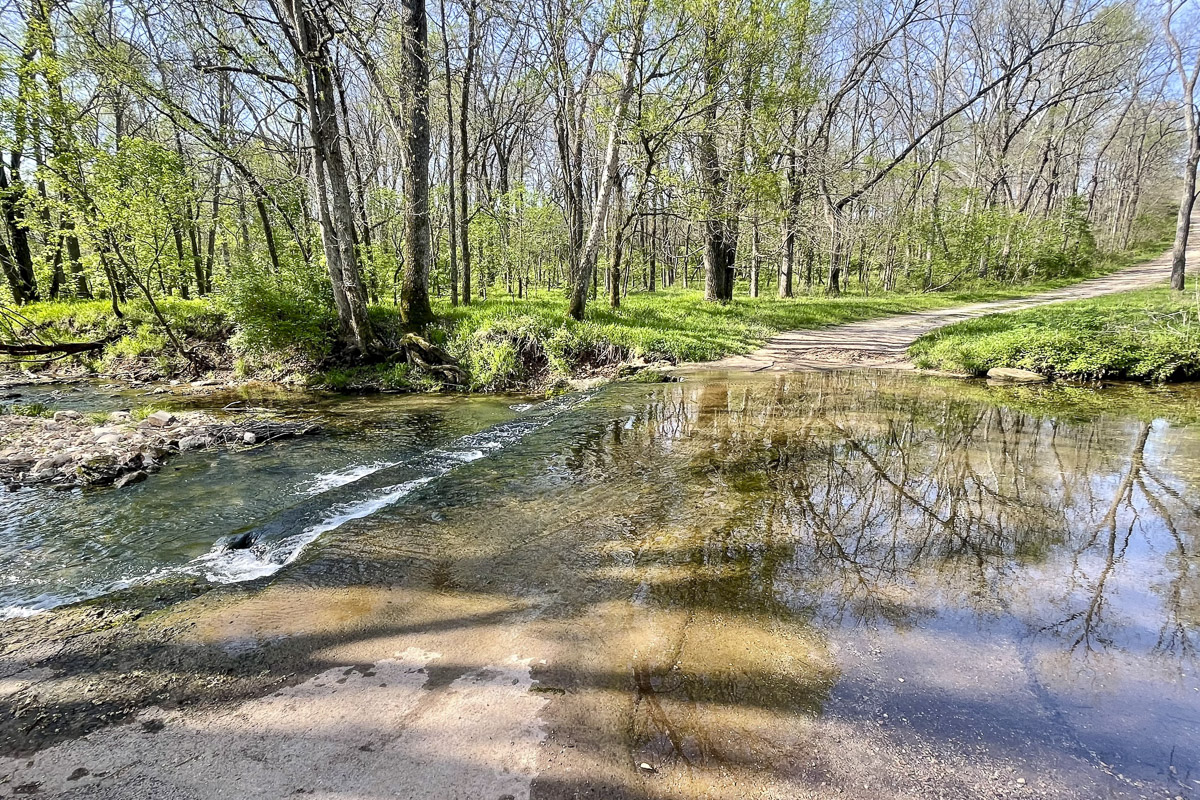
Continue along the road until you reach Wilson’s Creek again (altogether, roughly less than half a mile from the Pulaski Trail bridge). If the water level is down, it’s easy to cross the low-water bridge here if you want to continue. If it’s up, expect wet feet and potentially slippery concrete. We usually turn back and connect to other trails from this section of Wire Road.
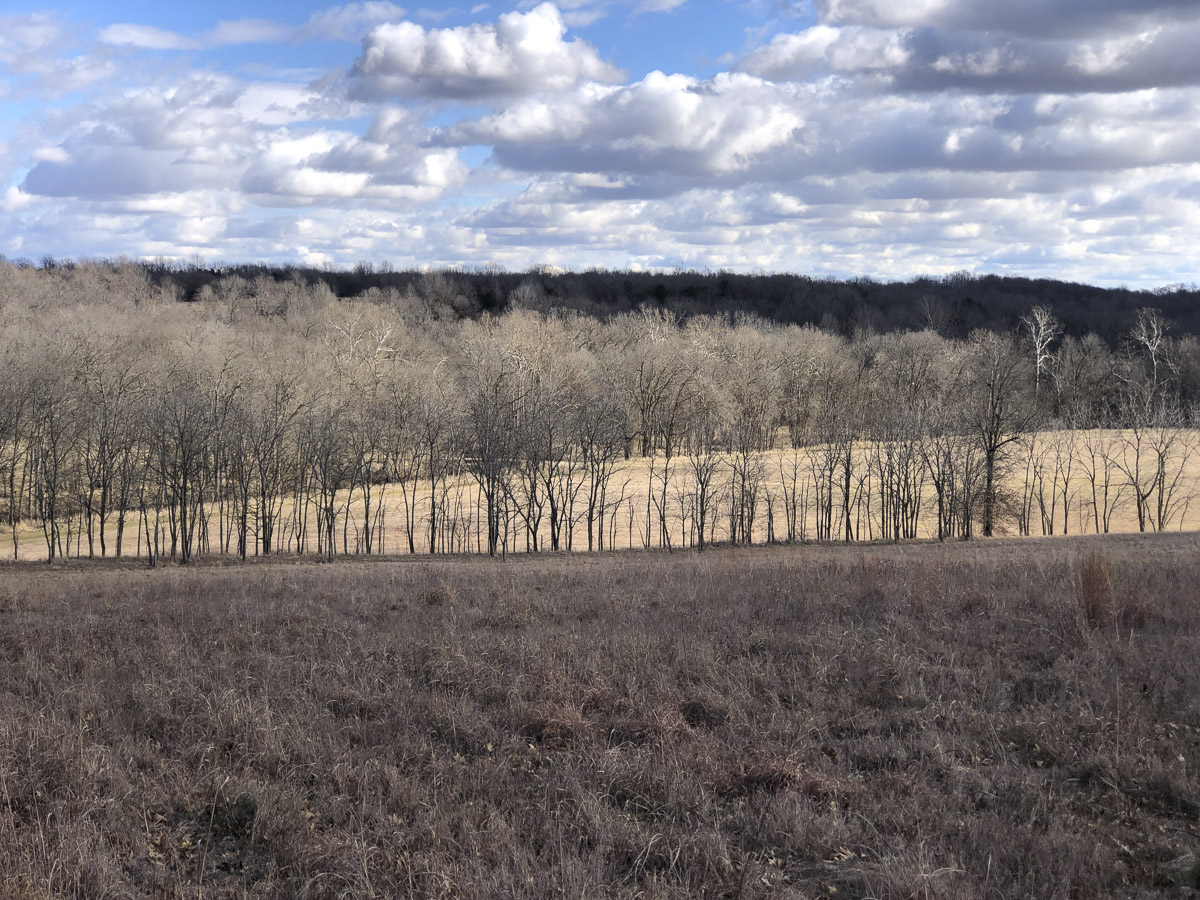
Bloody Hill Spur: You can get to the Bloody Hill Trail by following a rather steep half-mile uphill spur — rated as difficult by the park for its elevation — from Wire Road.
Click for more details
As you get toward the top of this spur, the view of the battlefield below is lovely any time of year, and stopping to look will help you catch your breath from the uphill hike! At the top, the spur turns north to meet the Bloody Hill Trail. Along the northbound trail, take a short spur to see the Lyon Marker (the site where General Lyon was mortally wounded), then return and keep going to the Du Bois’s Battery. From here, turn back or follow the trail all the way to Tour Road Stop 8 (the Bloody Hill Trailhead).
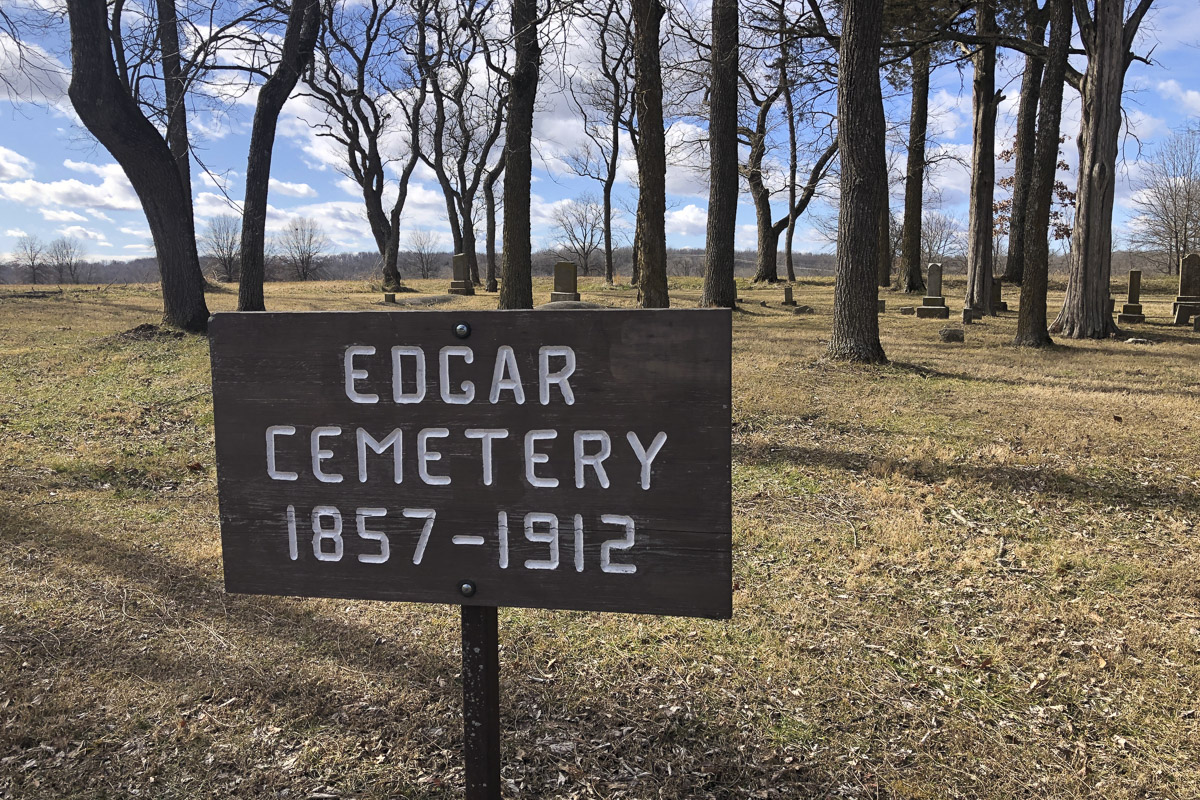
Ray Cornfield Trail: Another great route you can do on its own or combined with others, this trail also starts after crossing the bridge at the bottom of the Pulaski Trail.
Click for more details
Sometimes I add the Ray Cornfield trail after visiting the cabin or hiking the Bloody Hill Spur, but just as often I choose this trail and take it all the way north. Or you can combine it with the Gibson’s Mill Trail. The trail is a pleasant, easy-moderate hike with some elevations along the way.
If you stay on the trail (about one mile each way), eventually you’ll reach the Tour Road just east of Stop 1 and can cross over to visit the small Edgar Cemetery (1857-1912). From here, instead of retracing your steps, you could walk along the tour road heading west to Stop 1 and return via the Gibson’s Mill Trail.
Another option from the Pulaski Trail is to follow the Ray Cornfield Trail to the Gibson’s Mill Trail turnoff, then continue on Gibson’s Mill Trail to its trailhead at Tour Road Stop 1.
Tour Stop No. 1 / Gibson’s Mill Trail
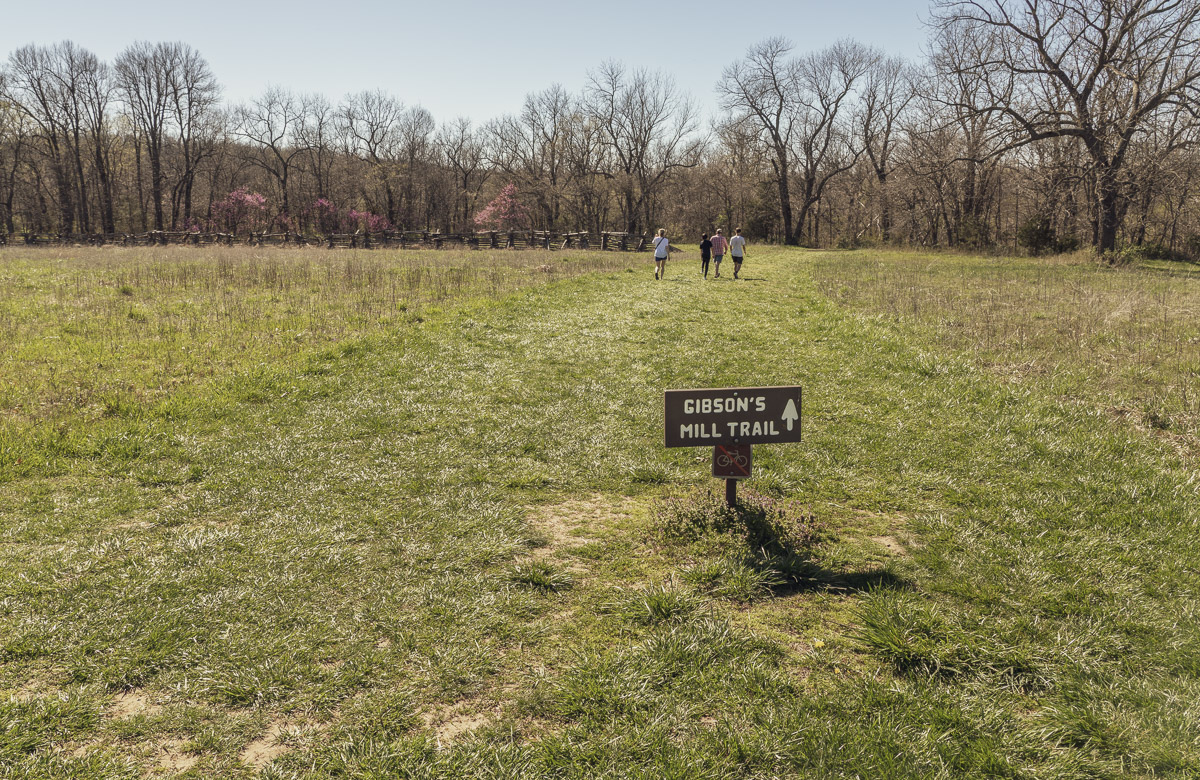
We started this guide with trails from Tour Stop 3 because it’s so central.
But for a short, pleasant and historic trek in the woods along Wilson’s Creek, the Gibson’s Mill Trail is a nice easy half-mile option.
Click for more details
If you read the Stop 3 trail guide, you know the Gibson’s Mill Trail connects with other trails. But the roughly 1-mile trail is nice on its own, too. The trail starts along an open path where one of the park’s many miles of split rail fencing begins. Once it enters the woods, it meanders along the creek, passing by the historic site where Gibson’s Mill and the Gibson house once stood. The house was significant for serving as the Confederate Army’s most northern camp headquarters. (If you want to extend your hike from Gibson’s Mill, check the guide under Stop 3.)

Stop 1 is a favorite of mine for photographing trees in the field, wildflowers, the split rail fencing and a view of Wilson’s Creek from the nearby bridge.
Tour Stop No. 5 / Wire Road and Southwest trails

To hike around the edges of the park along three connecting trails, Tour Road Stop 5 makes a convenient place to start.
This is also one of the horse-friendly routes.
Click for more details
When you want a longer, moderately challenging hike to see something different, head for the outskirts. You can follow the Wire Road Trail from Stop 5 southwest up the hill, passing Sharp’s Farm site, and soon you’ll be hiking in the woods. Eventually, the trail connects with the Southwest Trail, so named because it skims the southwest boundary of the park.
That trail eventually curves to cross open fields and toward the creek. The park trail map shows it crossing the creek to get on the Manley Uplands Trail (often used by horse riders) but we just follow a path back to the tour road between the bridge and Stop 4. From here, follow the tour road back to your car at Stop 5.
An alternative is to park at Stop 3, walk the tour road over the bridge until you see where the path cuts south from the road into the field, and reverse the trail. Once you come down the hill on the Wire Road Trail to Stop 5, you can either walk back to Stop 3 along the road, or follow the Wire Road Trail to the low-water bridge, cross over and continue back to your car. (Tip: The last time we did this reverse route, our shoes got soaked from crossing the creek at the low-water bridge. But at least it was the last part of the hike!)
Depending on where you start and how much you walk the tour road, this hike could range from nearly three to four miles.
Tour Stop No. 7 / Bloody Hill Trail
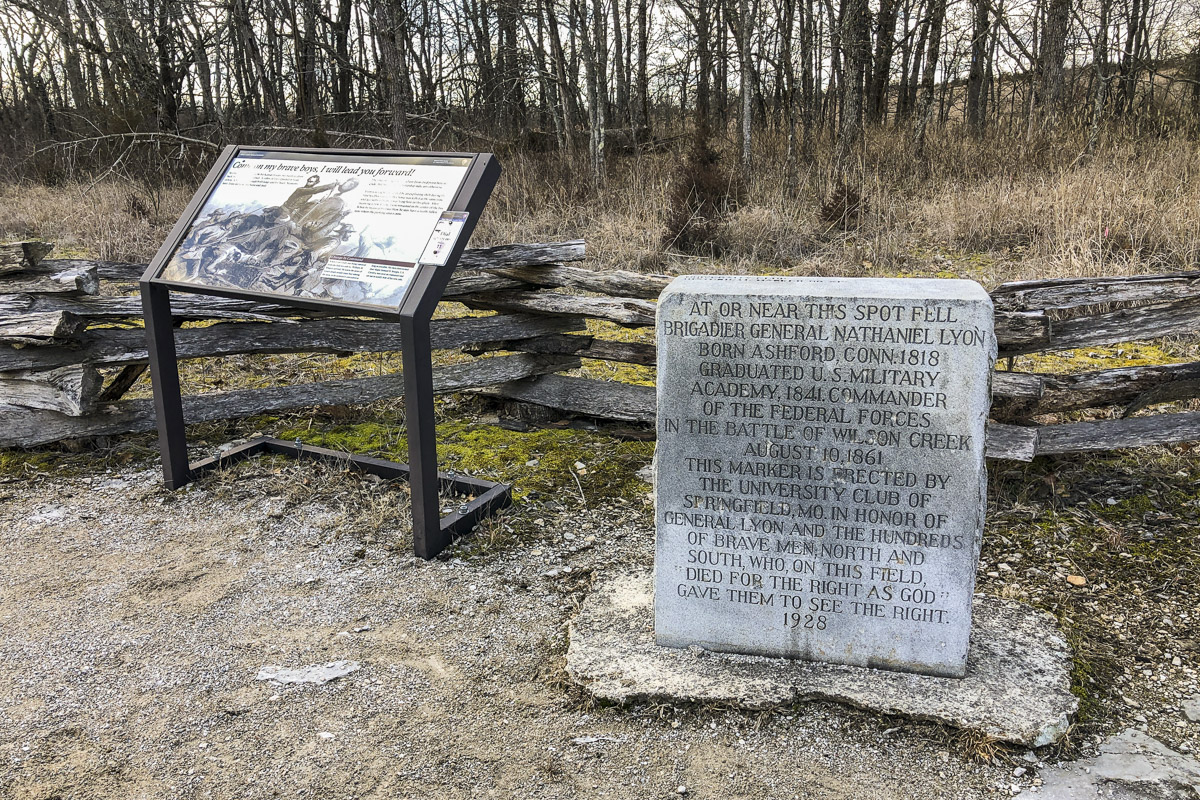
By now you likely realize that every trail eventually connects to every other trail in the park.
The Bloody Hill Trail is yet another way to enter the depths of the battlefield and natural spaces.
Click for more details
As we mentioned in our Stop 3 guide, you can get to Bloody Hill via a spur from the Wire Road. But if you don’t want to conquer that steep hike to see this part of the park, start at the Bloody Hill trailhead for a shorter, easier option. This trail leads to locations where the early morning, five-hour battle took place, killing General Lyon and leaving more than 2,500 losses total for both sides.
From the parking lot, follow the trail which passes Totten’s Battery to a T-intersection. Turn left to see Du Bois’s Battery. Turn right to head toward the Bloody Hill Spur, taking a side spur to the Lyon Marker at the site where it’s estimated he was wounded. From here, turn back or use trail suggestions from the Stop 3 guide to continue your hike.
Love the park? Volunteer!
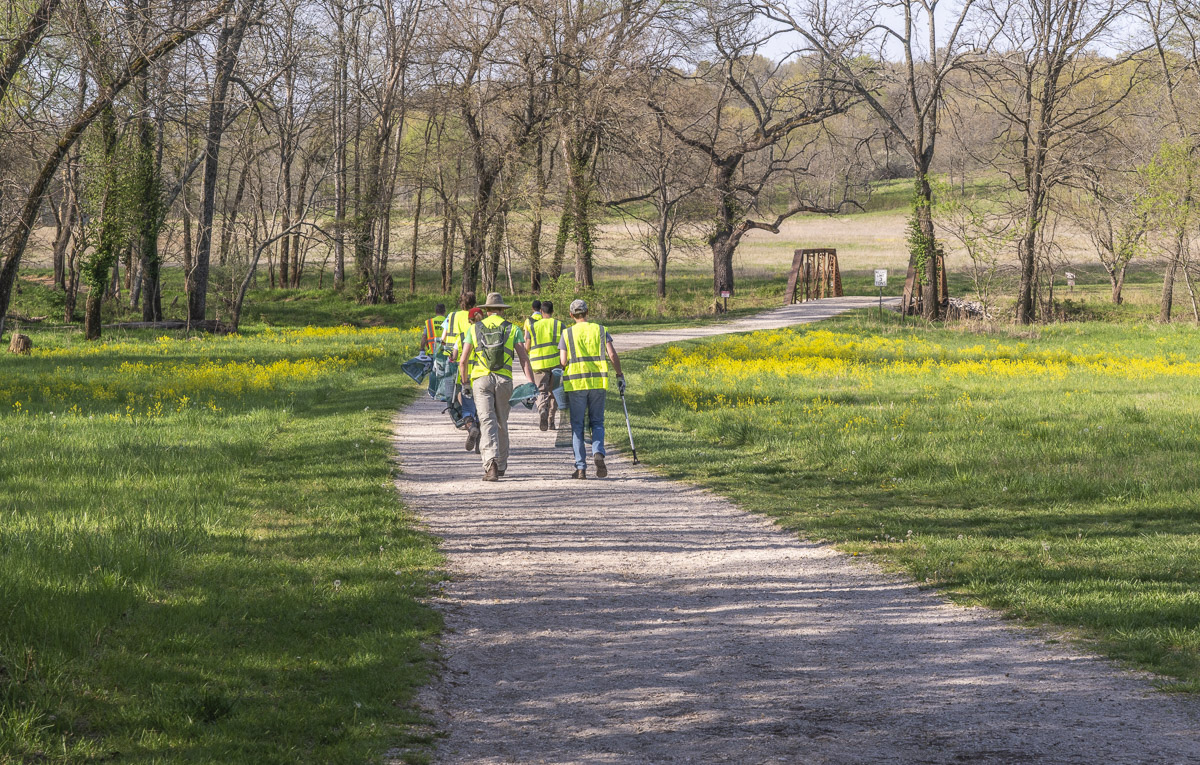
Wilson’s Creek Chief of Interpretation Alicea Powell credits volunteers for helping to make the park the best it can be and shares information for how people can help.
Click for more details
“We have a really fantastic group of volunteers who dedicate a lot of time, both to helping visitors, touring the Ray House and whatnot, and helping to put things in context,” she said. “I think that's one of the great things about National Park Service sites in general. There is a pretty good focus on interpretation and visitor services.”
Even with all the interpretative signage, Powell says market data shows that when visitors interact with knowledgeable staff, rangers or volunteers, it increases their appreciation and enjoyment of a place. The access to staff is one thing that sets Wilson’ Creek National Battlefield apart from other local outdoor green spaces, she said.
Volunteers at Wilson’s Creek help with Living History events and activities, give tours, hand out park materials, introduce the film and help behind the scenes with photographs, library collections, compiling data and more. Volunteers also help with clean-up and projects. For more information about volunteering, visit the National Park Service website or call 417-732-2662, ext. 389.


